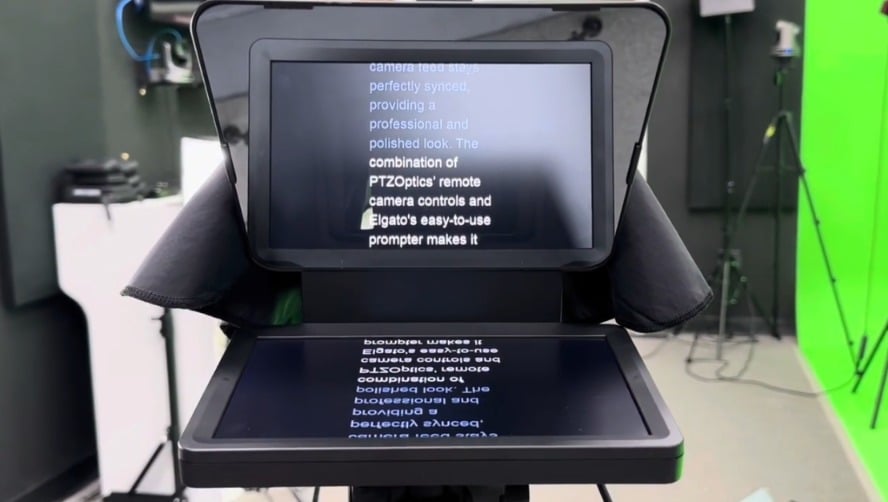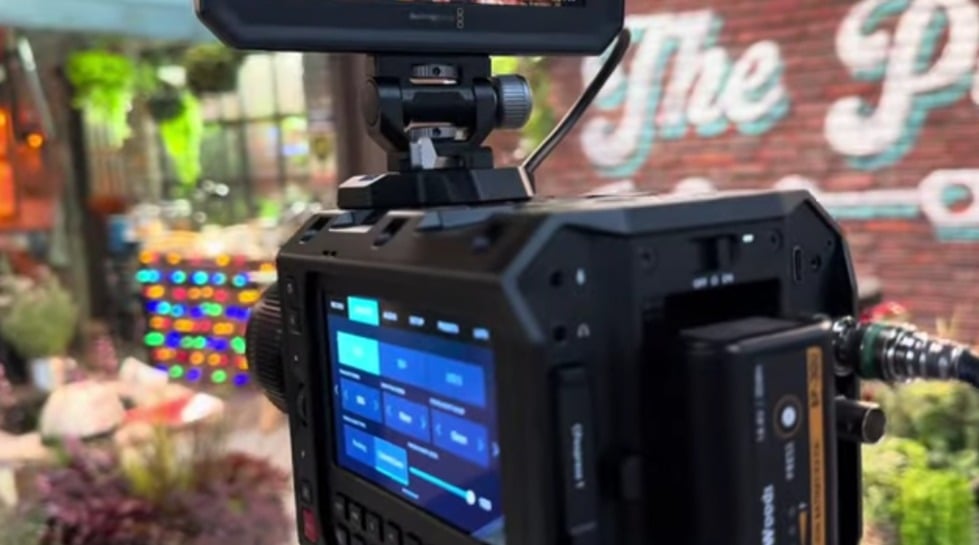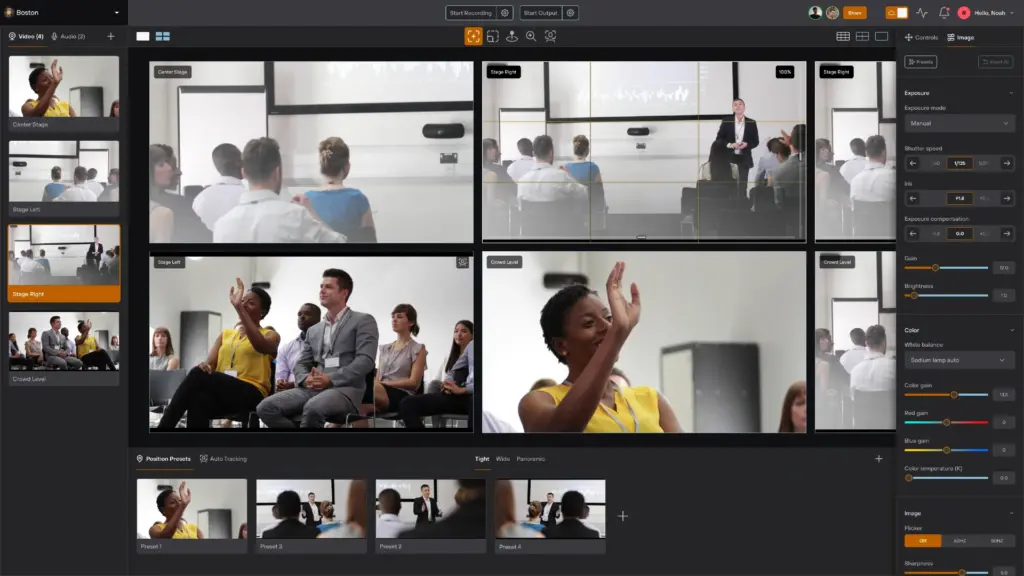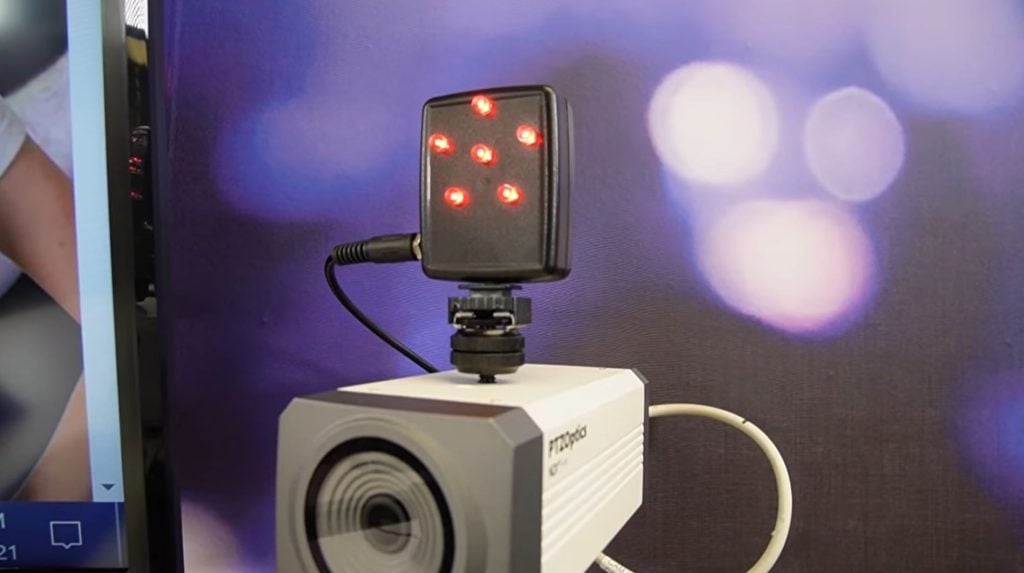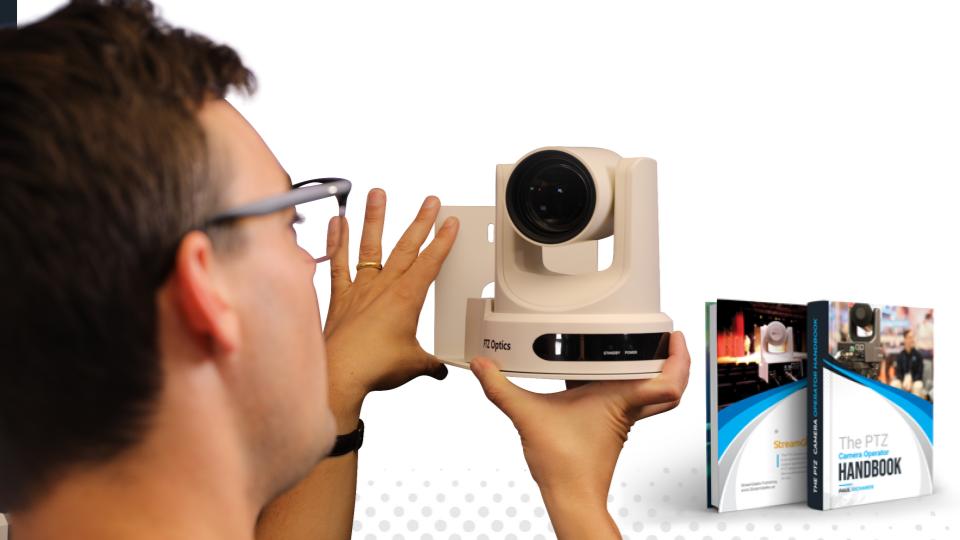Setting PTZ Camera Exposure
Written by Paul Richards on November 17, 2021
Every PTZ camera operator should be concerned with getting the best possible picture from their cameras. This is done, in part, by adjusting the camera’s exposure and additional settings to adjust the picture quality. As a PTZ camera operator, you should know your camera and communicate with your team about basic parameters.
An ideal starting place for any project is to outline the project’s resolution and frame rate. The project should have one master resolution and frame rate that is used with the cameras, the video production software, and any recording or live-streaming devices. Once you know the desired resolution and frame rate for the project, you should make sure that every camera in the system is set to the exact same setting. The last thing you want is to have one camera that is set at a different frame rate from the rest, because that will create a noticeable inconsistency with your video. If you have most of your cameras set to 30 frames per second for example, and only one camera set to 60 frames per second, the camera with 60 frames per second will have a noticeable difference in the amount of blur captured by the video. The next step is to dial in your camera’s exposure in order to get the most out of the lighting conditions available. Knowing the project’s resolution and frame rate will allow you to use the 180° shutter speed rule as a starting point to tune your camera’s exposure.
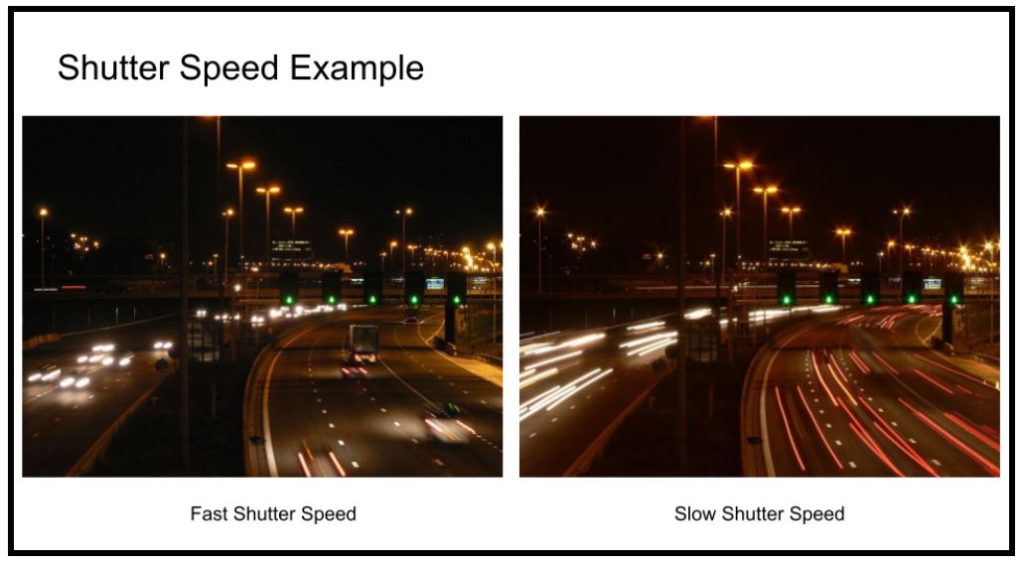
Shutter Speed Example
The 180° shutter speed rule
The 180° shutter speed rule is designed to achieve a normal amount of motion blur from the video you are capturing from your camera. Every camera has a shutter that is used to control the amount of light that is exposed to the camera’s image sensor. The shutter speed is a controllable length of time that the shutter opens and closes each second. The image below shows the difference between two shutter speeds when taking a picture.

The 180-degree shutter speed rule
When shooting video, the shutter speed will alter the amount of blur that is visible when objects move. Video with a shutter speed that is too low will have an unrealistic amount of blur. Video with a shutter speed that is too high will have almost no blur even when objects are moving quickly. The 180° shutter speed rule helps videographers establish a realistic amount of blur based on the number of frames your camera is capturing. This rule has become a standard in the film industry to match what the human eye is used to seeing in real life.
The good news is that the 180° shutter speed rule is easy to apply. All you need to do is double your project’s frame rate to get your recommended shutter speed per second. For example, if your project’s frame rate is 30 frames per second, your shutter speed should be 1/60th of a second. If your project’s frame rate is 60 frames per second, your shutter speed should be 1/120th of a second.
Adjusting the camera’s aperture
When it comes to properly balance a camera’s exposure, your primary tools are aperture and shutter speed. The aperture is the opening of the camera’s iris located in the lens. Similar to shutter speed, adjusting the aperture will increase or decrease the amount of light sent to the camera’s image sensor. The aperture can have an effect on the depth of field your camera captures. A large aperture will create a shallow depth of field and a small aperture will create a large depth of field.
Most PTZ cameras are used to capture video footage and unlike photography, you will likely lock the shutter speed and frame rate in order to capture video with the proper amount of motion blur. Therefore, the aperture is your main tool to balance the exposure because the shutter speed is essentially locked. One starting point for aperture adjustment is to use your PTZ camera’s shutter speed priority option. The shutter speed priority option allows you to lock the shutter speed at a specific rate and allow the camera to automatically adjust the aperture. You can do this to get an idea of what the camera thinks the ideal aperture is, and then switch the camera into manual mode to tweak the setting.
Most exposure setting modes to adjust inside ]your PTZ camera using the on-screen display (OSD) menu. Additional settings may include backlight, gain limit, anti-flicker, meter, and “Dynamic Range Control” (DRC), a technology used to compensate for problems in your exposure due to a variety of lighting scenarios. The backlight feature removes unwanted backlighting from a specific scene. The gain limit o increases or decreases the gain used to enhance the picture’s brightness. The anti-flicker option is used when the lighting in your space causes a flicker in the video.
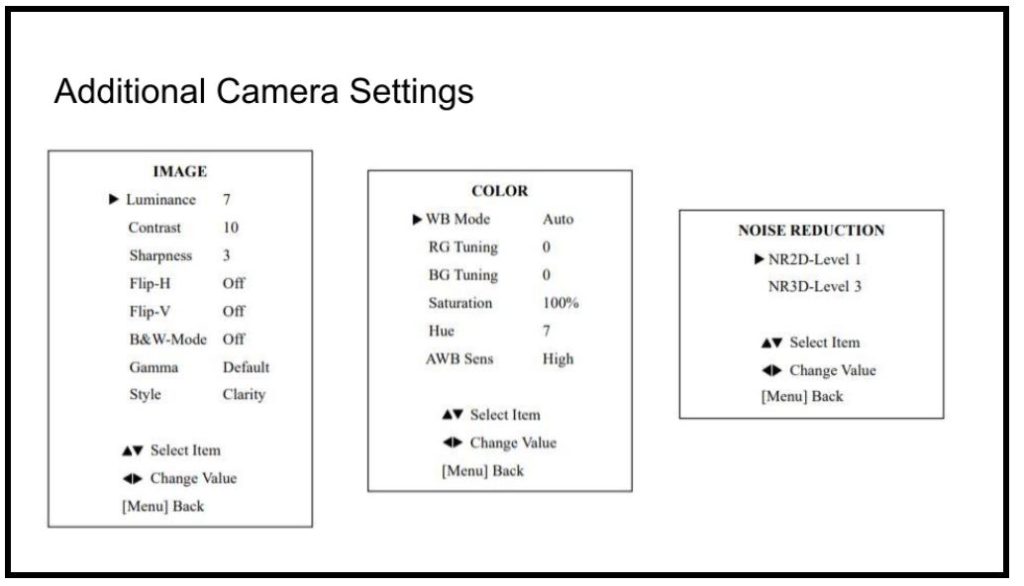
Camera Settings for Exposure
Additional Camera Settings
Once you have tuned your aperture and shutter speed, you may find it useful to adjust additional video settings. Most PTZ cameras will allow you to adjust the image, the color, and some noise reduction functions. These settings allow you to digitally enhance the image that is produced by your exposure settings.
At this point, the best place to start is to white balance your camera. White balancing your camera allows the camera to identify what a white object should look like in your environment and tune the rest of the colors in your camera. Check to see if your camera features a “one-push” white balance option. This will allow you to zoom into a white object or sheet of paper and have your camera automatically make a white balance adjustment.
The next step is to tune the colors coming from your camera. This is an important step especially if you are attempting to color match multiple cameras.When color matching cameras, use a color chart to provide accurate representations of color that you can use to see where you need to make adjustments.. A color chart can be placed in a common area and zoomed into with all of your PTZ cameras. Some PTZ cameras also offer the ability to adjust the color of the camera based on the color temperature of your lights. Once you have properly adjusted one camera, write the settings down and try applying the same settings to additional cameras in your system. You may find that each camera has a unique viewpoint that requires adjustment. As a best practice, use the color settings of the camera that is properly adjusted and look good, to change the settings on the rest of your cameras.
Once you feel good about the camera’s color settings, move on to image enhancement. The settings in this area include brightness, contrast, luminance, gamma, and sharpness. Contrast and luminance are a bit like the aperture and shutter speed except the changes are not being made to the exposure, but a digital reproduction being output by the camera. You can use the contrast adjustment to add dimension to your video. Good contrast should add a full range of color tones with accurate whites and blacks.
In an ideal world, your camera’s exposure should look perfect by simply using the shutter speed and aperture. But, in many cases, additional settings, such as contrast and luminance are required to digitally enhance your image in cases where you have low light or other challenging environments. The luminance can be used to add or remove brightness from your images. You should try to balance contrast and luminance until you get a crisp, sharp picture.
Tip: If you are using a green screen, contrast can help remove some of the stray pixels showing up through your chroma key.
It’s worth noting that many video production systems offer their own color correction tools. For example, vMix offers a waveform monitor and a vectorscope that can be used to manually color correct multiple cameras. This is especially useful if you are using cameras from multiple camera manufacturers. Color correction tools allow you to see the raw data that is coming into your video production system. Using this information, you can apply color corrections and filters in order to properly match the color from multiple cameras.
Here is a camera settings checklist:
- Set up cameras in their proper location
- Test with the lighting you plan to record with
- Configure the camera’s exposure settings (shutter speed and aperture)
- White balance the camera
- Check the colors using a color checker
- Compare the video of multiple cameras if necessary
- Color match cameras with the video production software you plan to use
Digital noise reduction is a final adjustment setting you may require. . Depending on how much gain and luminance you are using, you may come across digital pixelation. Digital noise is essentially pixels that are not getting enough light in your CMOS sensor; the pixels flicker from time to time. The first way to remove digital noise is to reduce the amount of gain and luminance you are using. If you can’t do that, try digital noise reduction options.
Key Takeaways:
- Follow the 180-degree shutter speed rule as a starting point for tuning your camera’s exposure
- Tuning the shutter speed and iris are the most important first steps toward setting up the correct camera exposure
- Using a color checker you can tune the white balance and color settings on your cameras in the space you plan to use them
- A waveform monitor and a vectorscope are tools you can use to help color match and tune your video
Learn more about PTZ Cameras
- See how PTZ cameras are transforming video production here
- Learn high level, what a PTZ camera really is here
- Learn about every essential part of a PTZ camera here
- Learn about who is using PTZ cameras here
- Learn about the different types of PTZ cameras here
- Learn how to use an IR remote control with your PTZ cameras here
- Learn about the various PTZ camera control options here
- Learn how to mount a PTZ camera here
- Learn how to set the exposure of your PTZ camera here
- Learn about PTZ camera operation best practices here
- Learn about all the latest PTZ camera features here
- Learn how to automate PTZ camera controls here
- Learn more about Networking PTZ cameras here
- Learn about the new ePTZ camera technology here
- Learn about how innovations in video production are changing the industry here
- Learn how to use PTZ cameras for remote production here
